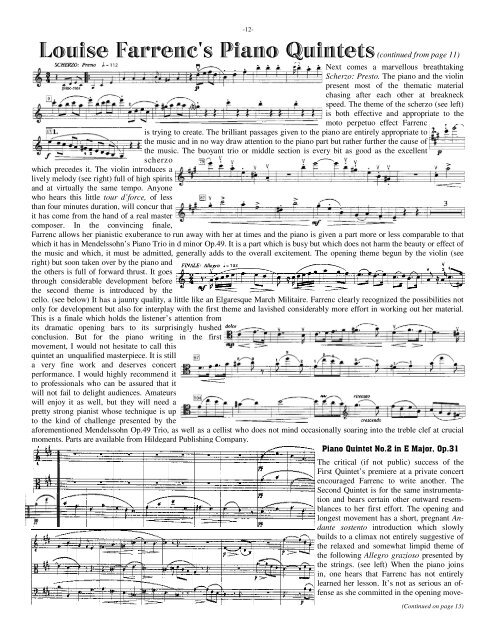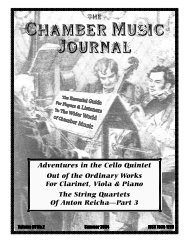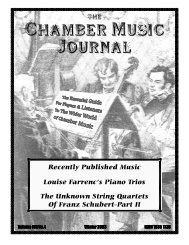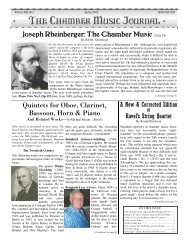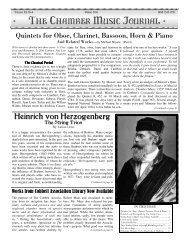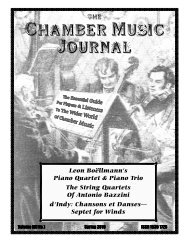Create successful ePaper yourself
Turn your PDF publications into a flip-book with our unique Google optimized e-Paper software.
-12-<br />
Louise Farrenc's Piano Quintets (continued from page 11)<br />
Next comes a marvellous breathtaking<br />
Scherzo: Presto. The piano and the violin<br />
present most of the thematic material<br />
chasing after each other at breakneck<br />
speed. The theme of the scherzo (see left)<br />
is both effective and appropriate to the<br />
moto perpetuo effect Farrenc<br />
is trying to create. The brilliant passages given to the piano are entirely appropriate to<br />
the music and in no way draw attention to the piano part but rather further the cause of<br />
the music. The buoyant trio or middle section is every bit as good as the excellent<br />
scherzo<br />
which precedes it. The violin introduces a<br />
lively melody (see right) full of high spirits<br />
and at virtually the same tempo. Anyone<br />
who hears this little tour d’force, of less<br />
than four minutes duration, will concur that<br />
it has come from the hand of a real master<br />
composer. In the convincing finale,<br />
Farrenc allows her pianistic exuberance to run away with her at times and the piano is given a part more or less comparable to that<br />
which it has in Mendelssohn’s Piano Trio in d minor Op.49. It is a part which is busy but which does not harm the beauty or effect of<br />
the music and which, it must be admitted, generally adds to the overall excitement. The opening theme begun by the violin (see<br />
right) but soon taken over by the piano and<br />
the others is full of forward thrust. It goes<br />
through considerable development before<br />
the second theme is introduced by the<br />
cello. (see below) It has a jaunty quality, a little like an Elgaresque March Militaire. Farrenc clearly recognized the possibilities not<br />
only for development but also for interplay with the first theme and lavished considerably more effort in working out her material.<br />
This is a finale which holds the listener’s attention from<br />
its dramatic opening bars to its surprisingly hushed<br />
conclusion. But for the piano writing in the first<br />
movement, I would not hesitate to call this<br />
quintet an unqualified masterpiece. It is still<br />
a very fine work and deserves concert<br />
performance. I would highly recommend it<br />
to professionals who can be assured that it<br />
will not fail to delight audiences. Amateurs<br />
will enjoy it as well, but they will need a<br />
pretty strong pianist whose technique is up<br />
to the kind of challenge presented by the<br />
aforementioned Mendelssohn Op.49 Trio, as well as a cellist who does not mind occasionally soaring into the treble clef at crucial<br />
moments. Parts are available from Hildegard Publishing Company.<br />
Piano Quintet No.2 in E Major, Op.31<br />
The critical (if not public) success of the<br />
First Quintet’s premiere at a private concert<br />
encouraged Farrenc to write another. The<br />
Second Quintet is for the same instrumentation<br />
and bears certain other outward resemblances<br />
to her first effort. The opening and<br />
longest movement has a short, pregnant Andante<br />
sostento introduction which slowly<br />
builds to a climax not entirely suggestive of<br />
the relaxed and somewhat limpid theme of<br />
the following Allegro grazioso presented by<br />
the strings. (see left) When the piano joins<br />
in, one hears that Farrenc has not entirely<br />
learned her lesson. It’s not as serious an offense<br />
as she committed in the opening move-<br />
(Continued on page 13)


